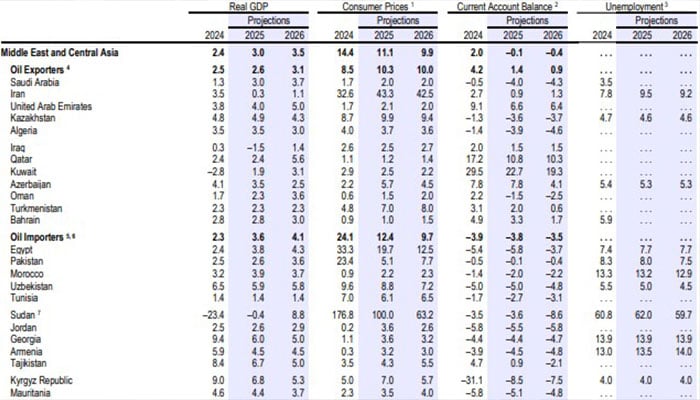- Unemployment to remain steady at 8%.
- Inflation seen rising to 7.7% next year.
- Current account deficit to surge to 0.4%.
ISLAMABAD: The International Monetary Fund (IMF) has downgraded Pakistan’s economic growth projection for the current fiscal year from 3% to 2.6% in its World Economic Outlook report released this week.
The revised forecast follows fresh US tariff hikes of up to 29% by US President Donald Trump, which have led the IMF to cut growth estimates for several developing economies.
The report, however, noted that Pakistan’s GDP growth for the next fiscal year (2025–26) is projected to rise to 3.6%.
Inflation in Pakistan — which stood at 23.4% in 2024 — is forecast at 5.1% for the current fiscal year, with the IMF projecting it to rise further to 7.7% in the next fiscal year.
The IMF also revised its forecast for Pakistan’s current account deficit. It now expects the deficit to stand at 0.1% of GDP, compared to its earlier estimate of 1%. In nominal terms, the current account gap is expected to be just $400 million, instead of the previously projected $3.7 billion.
For 2026, the lender expects the current account deficit to further increase to 0.4% of the GDP.
The unemployment rate is projected to remain at 8% in 2025 — down from 8.3% in 2024 — with a further expected decrease to 7.5% in 2026, according to the report.
The IMF’s World Economic Outlook highlighted that the recent tariff escalation by the US has led to a general weakening of growth forecasts across emerging markets and developing economies.

Pakistan, along with several other countries in the Middle East and Central Asia, is expected to face economic pressures due to disrupted trade and rising global financing costs.
The report comes against the backdrop of Finance Minister Muhammad Aurangzeb’s presence in Washington for the World Bank Group and IMF Spring 2025 meetings during which the minister has held several key meetings with business leaders and those from financial institutions.
Aurangzeb, during his meeting with IMF Managing Director Kristalina Georgieva, has reaffirmed the government’s commitment to reforms.
Meanwhile, attending an IMF-hosted panel discussion titled “Revenue Mobilisation in the Medium Term,” the finance czar outlined Islamabad’s efforts to broaden and deepen the tax base to ensure that sectors like agriculture, real estate, and retail contribute proportionally to GDP.
Furthermore, during a meeting with institutional investors, he also stressed the country’s macroeconomic stabilisation and the recent credit rating upgrade by Fitch, which has opened avenues for Pakistan’s return to financial markets through enhanced investor confidence.
The Washington-based lender’s revised forecast is not limited to Pakistan but includes several countries as well as the global statistics, The News reported on Wednesday.
In its report, the IMF cut its forecast for global growth by 0.5 percentage point to 2.8% for 2025, and by 0.3 percentage point to 3% from its January forecast that growth would reach 3.3% in both years.
It said inflation was expected to decline more slowly than expected in January, given the impact of tariffs, reaching 4.3 per cent in 2025 and 3.6 per cent in 2026, with “notable” upward revisions for the US and other advanced economies.
The IMF called the report a “reference forecast” based on developments through April 4, citing the extreme complexity and fluidity of the current moment.
“We are entering a new era as the global economic system that has operated for the last 80 years is being reset,” IMF chief economist Pierre-Olivier Gourinchas told reporters.
“It is quite significant and it’s hitting all the regions of the world. We’re seeing lower growth in the US, lower growth in the euro area, lower growth in China, lower growth in other parts of the world,” Gourinchas told Reuters in an interview.
“If we get an escalation of trade tensions between the US and other countries, that will fuel additional uncertainty, that will create additional financial market volatility, that will tighten financial conditions,” he said, adding the bundled effect would further lower global growth prospects.
— Additional input from APP


